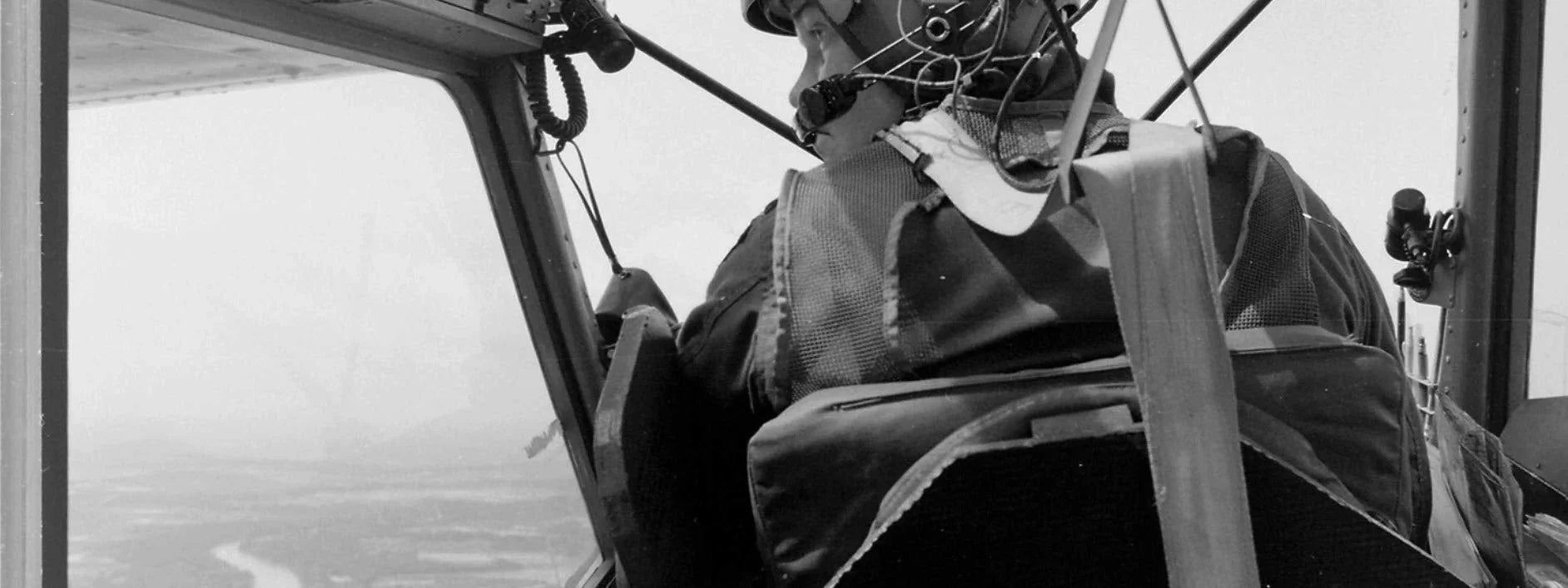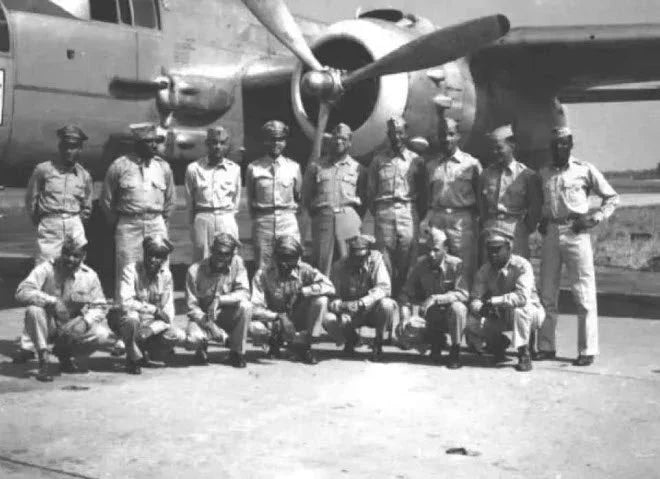1st Lt. Charles Blakesly Hall, U.S. Army Air Corps

A World War II German Focke-Wulf 190 fighter in flight.
Buster
On August 25, 1920, at his parents (Franklin Hall & Anna Blakesly Hall) home, a young boy was born in Brazil, Indiana. He was named Charles Blakesly Hall.
As it turned out, young Charles Blakesly Hall had a knack for not only academics, but also was an excellent football player and track and field competitor. Upon graduation from Brazil High School he attended Eastern Illinois University majoring in Pre-Medicine.
While at college Hall played sports and workied a job as a waiter to pay his way through college.
Around this time, President Roosevelt opened up a pilot training program to African-Americans. Hall applied and was selected to train at Tuskegee Institute in Alabama.
On November 12, 1941, Hall enlisted in the U.S. Army Air Corps as an aviation cadet at Fort Benjamin Harrison in Lawrence, Indiana.
His military records record his height as 5 feet, 7 inches, and a weight of 150 pounds.

Aviation Cadet Charles B. Hall, U.S. Army Air Corps, circa 1941 (NASM)
Young Charles Hall was part of a new group of African-American airmen who would come to be known as the Tuskegee Airmen.
These men were trained at the Tuskegee Institute in Tuskegee, AL, an all-black college which was founded by Booker T. Washington in 1881.
Initial flight training took place at Moton Field which was located a few miles away for the Tuskegee Institute.
The cadets then transitioned into operational aircraft at the Tuskegee Army Air Field, followed by additional flight training at Cochran Field which was located near Montgomery, Alabama.
On July 3, 1942, Hall graduated from the fourth Cadet Class Single Engine Section SE-42-F as a 2nd Lt. and earned his wings.
By this time he had earned the nickname “Buster.”
On December 14, 1942, Lt. Hall married Miss Maxine Jessie Parash, a stenographer, in Vigo County, Indiana.

Captain and Mrs. Charles B. Hall (Maxine Parrish Hall), circa 1945.
World War II
2nd Lt. Hall was then assigned to the 324th Fighter Group, but shortly thereafter he joined the 332nd Fighter Group, 99th Fighter Squadron.
The 99th Fighter Squadron was the first unit to be assigned overseas, and the unit was sent to North Africa on April 2nd, 1943, as part of the 33rd Fighter Group.
By this time he had been promoted to a 1st Lieutenant and had become proficient in flying the P-40L aircraft that he would be assigned to fly in combat.
As the war progressed the 99th was moved to the ElHaouaria Airfiled on the coast of Tunisia where their primary mission was to patrol the island of Sicily and provide ground attack missions.
On July 2nd, 1943 the 99th was tasked with providing escorts for B-25 Mitchell bombers operating near Castelvenrano in western Sicily.
Soon, enemy fighters appear and intercept the flight of bombers.
Here is how Buster (1st Lt. Hall) describes the action:
"It was my eighth mission and the first time I had seen the enemy close enough to shoot him. I saw two Focke-Wulfs following the bombers just after the bombs were dropped. I headed for the space between the fighters and bombers and managed to turn inside the Jerries. I fired a long burst and saw my tracers penetrate the second aircraft. He was turning to the left, but suddenly fell off and headed straight into the ground. I followed him down and saw him crash. He raised a big cloud of dust."

1st Lieutenant Charles B. Hall, in the cockpit of his Curtiss-Wright P-40L Warhaw pointing out a swastika.
Lieutenant Hall "Buster" was officially credited with downing a Focke-Wulf FW 190 and becoming the first (and only) enemy fighter shot down by the 99th Fighter Squadron in 1943.
Upon landing back in Tunisia Lt. Hall was greeted as a hero, and as a reward he received a long-awaited special gift - the last bottle of Coca Cola which had been sequestered waiting "for the pilot who put the first notch in his guns," as Ollie Stewart wrote in the Afro-American Newspaper.
But the kudos didn't end there.
As it turned out, Gen. Dwight D. Wisenhower, Gen. Carl "Tooey" Spaatz, and Gen. James Doolittle happened to be touring North African airbases that day.
Gen. Eisnehower personally congradulated Lt. Hall on his success.

Lt. Charles B. Hall is congratulated by General Dwight D. Eisenhower on his success that day.
Lt. Hall became the first African-American to be awarded the Distinguished Flying Cross, and by war's end he had flown a total of 198 combat missions and promotion to the rank of Major.

The Distinguished Flying Cross is awarded for a single act of heroism or extraordinary acheivement in aerial flight.
Lt. Hall's aircraft that day was a Curtiss-Wright P-40L-15-CU Warhawk, serial number 42-10895.
The Curtiss-Wright P-40L
The P-40L differed from the standard P-40s in that it was powered by a Packard V-1650-1 Merlin engine instead of the standard Allison V-1710.
The P-40L was a lighter version of the P-40 and incorporated a number of changes to the airframe.
They included the removal of armor plating, four Browning AN-M2 .50 caliber machine guns with only 201 rounds of ammunition instead of the standard six Browning machine guns on the normal P-40, and the internal fuel capacity was reduced to 120 gallons instead of the standard 157 gallons.
Specifications:
- Wingspan: 37 feet, 3.5 inches;
- Length: 33 feet, 3 and 23/32 inches;
- Height: 10 feet, 7 and 25/32 inches;
- Empty weight: 6,870 pounds'
- Gross weight: 9,416 pounds;
- Maximum speed: 368 mph;
- Service ceiling: 31,000 feet;
- Range: 750 miles.
Engine:
The V-1650-1 was the first version of the Rolls-Royce Merlin to be built under license by the Packard Motor Car Company of Detroit, Michigan. I
It was developed from the Merlin XX and designated Merlin 28.
The Packard V-1650-1 was a right-hand tractor, liquid-cooled, supercharged, 1,649-cubic-inch-displacement single overhead cam 60° V-12 engine.
It had a compression ratio of 6.0:1, and required 100-octane aviation gasoline. It was rated at 1,080 horsepower at 2,650 r.p.m., and 1,300 horsepower at 3,000 r.p.m. for takeoff.
The Military Power rating was 1,240 horsepower at 3,000 r.p.m. at 11,500 feet , and 1,120 horsepower at 18,500 feet.
The engine drove an 11-foot (3.353 meter) diameter, three-bladed Curtiss Electric constant-speed propeller through a 0.477:1 gear reduction.
The V-1650-1 weighed 1,512 pounds. (Note: A study in 2013 indicated that at that time there were no Focke Wulf FW 190 aircraft active in the area; however, Messerchmitt Bf 109 were and had been assigned to defend against the B-25 bombers. Two Messerchmitts were lost on that day.
Even though this was the only victory in 1943, by the end of the war the Tuskegee Airman "Red Tails" had wracked up more than 100 confirmed victories by the conclusion of WW II. )
Major Charles B. Hall
During the war Hall toured the country encouraging people to invest in War Bonds to fund the war in Europe.
At the end of WWII Hall left the military with the rank of Major and was transferred to the U.S. Air Force Reserve. Like many of his African-American contemporaries, he was unsuccessful to secure work as a pilot with the commercial airlines.
He eventually settled in Oklahoma City in 1948 and began working in a drugstore before becoming a civil service employee at Tinker Air Force Base in 1949.
He worked at the base until 1967 when he moved on to the Federal Aviation Administration office in Oklahoma City until he retired in 1967.
While in Oklahoma Hall met Ms. Lola Delois Miles of Oklahoma City, and during their marriage they gave birth to two children and remained together until Hall's death on November 22, 1971.
Major Hall was buried at Hillcrest Memorial Gardens in Oklahoma City, Oklahoma.
In 2008, a bronze statue of Major Hall was erected to mark the entrance to the Major Charles B. Hall Airplark at Tinker Air Force Base.

This bronze statue of Maj Hall by Joel Randall is displayed at Tinker Air Force Base, Oklahoma City, Oklahoma.
His legacy lives on in history along with the many Tuskegee Airmen who served the United States with heroism which carries on to this day.
I hope you enjoyed this trip through some of the history of aviation. If you enjoyed this trip, and if you are new to this newsletter, sign up to receive your own weekly newsletter here: Subscribe here!
Until next time, keep your eyes safe and focused on what's ahead of you, Hersch!







1 comment
I was wondering if you are better at finding sources than I am.
I am a history teacher at the school where Charle B. Hall of the Tuskeegee Airmen attended. Brazil HS is now Northview HS. I am attempting to build a large scale model airplane of Mr. Halls planes that he was flying on his first kill. I can find a black and white picture, but I really need a color photo. I do know that it was not the P-51 “Red Tail,” but instead a P-40L-15-CU Warhawk, 42-10895.
Would you be of any assistance? I want something to leave the school when I retire.
Respectfully,
Brion Blanc
812-223-1412
Brion Blanc
Leave a comment
This site is protected by hCaptcha and the hCaptcha Privacy Policy and Terms of Service apply.